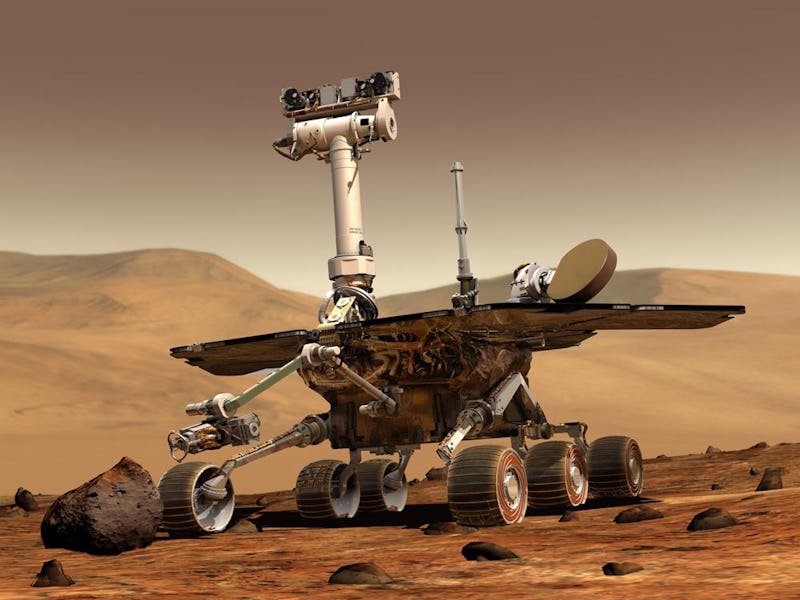NASA Photo Captures Opportunity Rover Getting Smothered by Mars Dust Storm

There’s nothing worse than a storm ruining weekend plans. Just ask NASA’s Opportunity Rover, which was in the middle of some very important Martian roving when a massive dust storm the size of North America completely blocked out the sun, thwarting the solar-powered robot’s plans by plunging it into endless night. Watching from afar, the Mars Reconnaissance Orbiter snapped a photo of Opportunity lost in the fray.
It would’ve been impossible to spot Opportunity in the photo, posted to NASA’s website on Friday, had the space agency not pointed it out with a tiny blue dot. The storm, which has been intensifying since June 1 — this photo was taken on June 6 — has smothered the rover in what NASA calls a “dark, perpetual night.” These are nightmare conditions for Opportunity, which has been forced to abandon its plans and sit tight in Mars’ Perseverance Valley until the dust storm is over, when it can finally recharge.
There remains, however, the chance that Opportunity might never come back.
The blue dot marks the position of the lonely Opportunity Rover, caught in a dust storm on Mars.
Being solar-powered, Opportunity needs sunlight to thrive and communicate with NASA’s Jet Propulsion Laboratory (JPL) in Pasadena, California. It’s got a decent capacity for energy storage, but according to NASA, by the time this photo was taken, it had already lost a lot of its power, forcing JPL to put an end to all of the rover’s research-gathering plans for the near future. Now, all of its energy must be diverted toward maintaining a line of communication with NASA and, perhaps even more importantly, staying warm.
The Martian night is cold, at times plummeting to -100 °F. As anyone whose smartphone has shut down unexpectedly in the winter knows, batteries don’t do well in the cold. Opportunity’s batteries are protected by survival heaters, but running them uses up a lot of energy, too. JPL has already witnessed the worst that could happen when Opportunity’s twin, Spirit, succumbed to death by cold in 2010, just six years after the siblings landed on the planet.
But Opportunity is a survivor. In the 14 years since it started exploring Mars, it’s weathered quite a number of dust storms, including one, in 2007, that sent the rover into minimal-energy, no-contact mode for nearly two weeks.
There’s no telling how long the dust storm will last, but it’s a pretty serious one, if the degree to which it’s obscuring the sun is any indication. According to NASA, the 2007 storm had an opacity level (also known as tau) above 5.5, while the current storm, which now covers over 16 million square miles, has reached 10.8. Dust storms are usually infrequent but can last weeks or even months, and, according to one NASA release, this summer marks a new “dust storm season” that will last until early 2019.
Opportunity might blame JPL researcher David Kass, Ph.D. for its current woes. In January, Kass, who has been studying the role of dust storms in Mars’ changing climate, said in a statement: “It would be great to have a global dust storm we could observe with all the assets now at Mars, and that could happen this year.” Here’s hoping that the brave, resilient rover, which has survived 14 years longer than it was expected to, continues to defy expectations — and that NASA scientists be a little more careful about what they wish for.